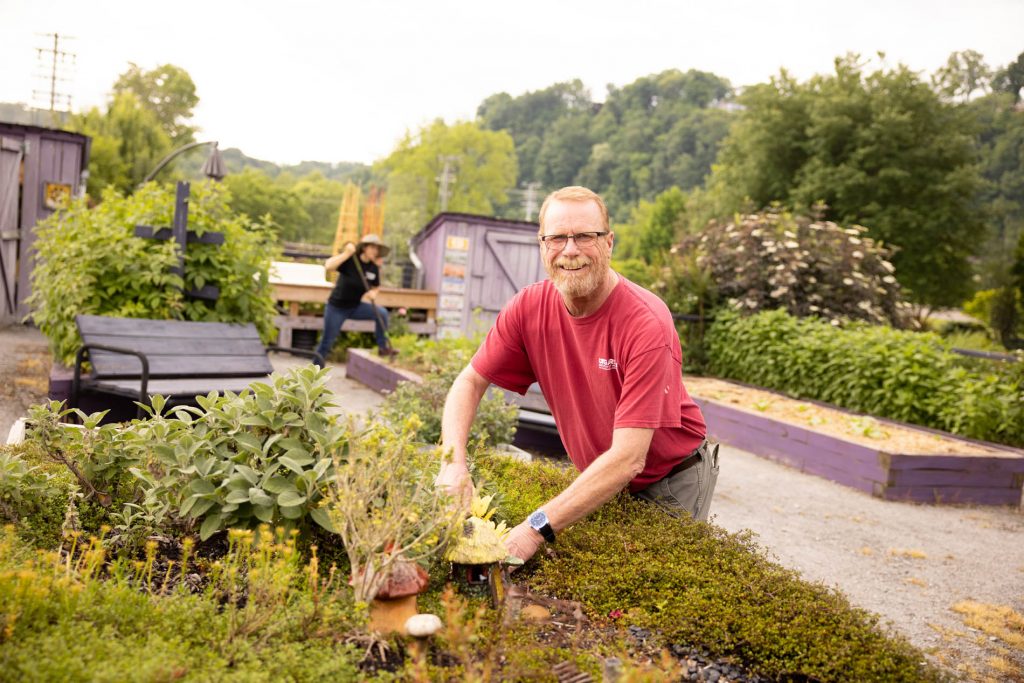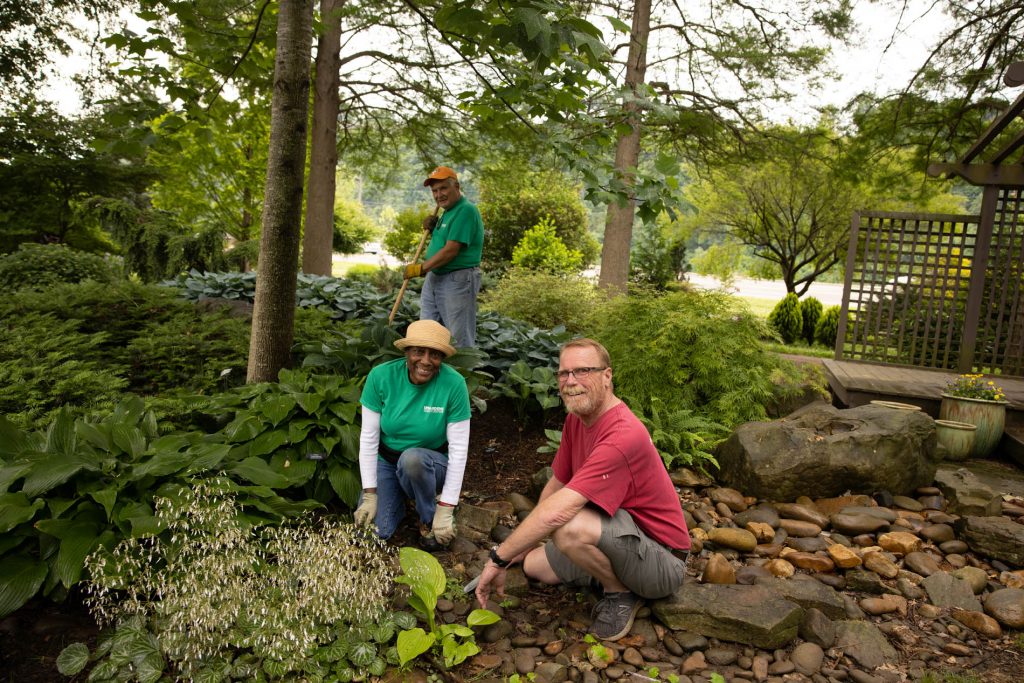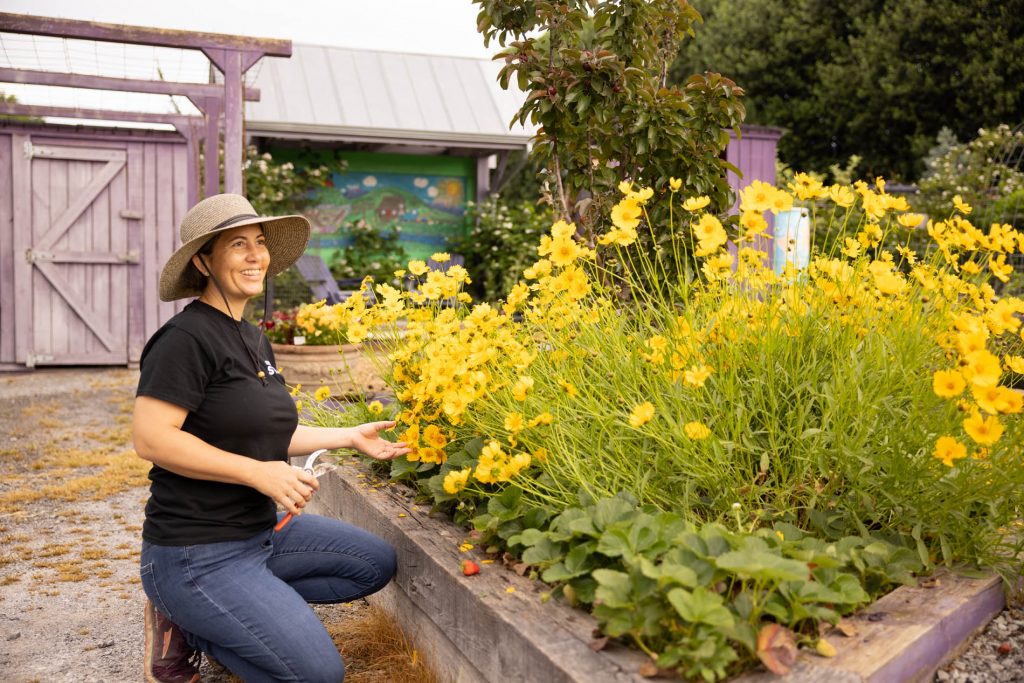The University of Tennessee Gardens provides knowledge, growth, and serenity for all who enter
It’s a Thursday morning in April in Knoxville and inside the University of Tennessee Gardens, volunteers, interns, professors, and gardens staff are already hard at work. They weed and tend to beds, enjoying their time outdoors and the mental respite it provides. The entire scene is lighthearted and carefree; it has the potential to make any visitor feel at peace as they roam the 10 acres.
James Newburn is part of this early morning crew. Newburn is the director of the gardens, but his journey with this important community space began in 1993, just about 10 years after the gardens opened at the university. Newburn worked at the gardens as a student intern while pursuing his bachelor’s in ornamental horticulture. He became the greenhouse manager after graduation, later receiving his masters in plant science with a concentration in public horticulture. He’s a living example of how impactful the gardens can be for students, “That’s where student internships can turn into career-shaping activities,” he says. “I got two degrees and never left.”

The gardens serve three purposes for the university. “It primarily functions as a living laboratory for the three missions that a land grant university like UT has,” Newburn explains. “And that’s research, teaching, and outreach.”
Some may recall the gardens being called the “Trial Garden” in the early years, Newburn recalls. At the time, the team there evaluated new plants that were not yet on the market, helping breeders understand if and how they could grow certain varieties in the mid-south region of East Tennessee.
That portion of the work continues today. In fact, right now you can see a massive display of hibiscus on the property, a breeding program started by a UT professor. “He’s looking at seeing if he can breed better, longer-blooming, strong-stemmed hibiscus for the commercial market,” Newburn says. “That’s the type of research that we do down here.”
In addition, the gardens serve as learning space for students. “If you’re a plant science student or a landscape architecture student or even an art student or education student, we use the garden as the laboratory for the university.” Students and professors from across the university’s disciplines take advantage of the gardens’ 10 acres. Newburn likens the space to a museum: it contains living collections. And much like a museum, the gardens are filled with art, created by members of the university—and greater—community.

Right now, visitors to the garden can view the latest community art project, a program started four years back in collaboration with professional and amateur artists. Each year, gardens staff provide interested artists with a blank slate of an item—this year a birdhouse—and the artists embellish them in whatever way they desire. If you walk through the gardens right now, you will see 53 birdhouses, decorated in various forms with artist names attached. “It will be in the garden through September,” Newburn says. “And at the end of the show, we have auctions, and people can come and participate…and get to take a piece of the artwork home with them.”
Hard-packed gravel walkways make their way throughout the gardens, and not just to view the public art. Aside from being a space for research and teaching, the gardens are open to the public all throughout the year to enjoy. “We try to have some of the newer varieties available on display that we plant and grow, that keep our collections vibrant,” Newburn says. And if something doesn’t perform well, they take it out and suggest to visitors that the variety might not be a good fit for East Tennessee. Even the public elements provide teachable moments.
The UT Gardens are home to a host of unique sub-gardens that it seems you’d only find at an education-based space. A family rose garden with roughly 130 varieties of roses is on site for viewing and enjoyment. An extensive hosta garden, with more than 500 varieties of the plant, is also on site paired with plants such as Japanese maples, hydrangea, and azaleas. There is a monarch butterfly way station garden—installed just last year—that provides food and respite as the monarchs migrate. There is an iris garden, even a children’s garden. “We just have this variety of horticultural displays available to the public to come and enjoy and learn more,” Newburn says.
There are tours, summer camps, homeschool programs, and more. The garden also boasts a therapeutic horticulture program, which has developed programming that the staff then takes out to assisted living facilities and other people unable to get to the garden. “We bring horticulture to them,” Newburn says, adding that the work they do with individuals through this program helps improve concentration and dexterity.
With a staff of eight, it’s hard to imagine all of these gardens being cared for so easily. But Newburn and his team are joined by interns and roughly 150 volunteers a year who work alongside them.
Knoxville native Holly Jones is part of the small staff and, like Newburn, has a history with the UT Gardens. After moving to Washington state from Tennessee, Jones found herself on an all-female landscaping crew in her early 20s, working at private residences off the coast of Seattle. But she longed to be in public horticulture. She moved back to Tennessee and entered UT with this focus in mind, eventually becoming a student intern at the UT Gardens. After graduation, Jones worked in various states in the horticulture realm until moving back to Tennessee once again in 2011. “When I came back, the garden had expanded and…they had this beautiful new edible garden with raised beds,” Jones says. After running into the then director, Jones was hired part-time to run the Demonstration (or Kitchen) Garden.

Today she wears a myriad of other hats for the gardens, though the demonstration garden is her sweet spot. Covering just a quarter of an acre, this demonstration space showcases for visitors all that is possible in a home residential garden. Education comes to life once again.“If you’re with a guide, there will be an opportunity to actually taste some of the produce that’s in season,” Jones says. Visitors can smell the herbs, learn about companion planting while seeing possible combinations of plants, and get up close and personal with the compost pile. Most of the plants in this garden are labeled, so if a variety is disease-free and thriving, residents can see how to make that happen.
Perennial food plants, such as berries and vines, that come back year after year are included in this space, along with some of the less common items such as hardy kiwi, kiwi berries (about the size of a large grape that look and taste like a kiwi), goumi berries, persimmons and figs. Visitors will find plants planted in-ground, in large containers, within raised beds (55 to be exact), even in straw bales. “It’s a way for people to just come, look, inspect, and hopefully be inspired,” Jones says, adding that she’s converted nearly every inch of the kitchen garden to usable growing space.
Aside from helping residents understand how to better tend to their own gardens, the demonstration garden carries with it an additionally important role: “It’s turned into a charity garden so now we grow food that supplies 11 area food banks,” Jones says. Working through a UT Institute of Agriculture service project called Grow More, Give More, the food grown in the garden is then passed off to the Society of St. Andrew in Knoxville which then brings it to local organizations who provide food to those in need.
Whether you’re looking to be inspired or simply there for a quiet stroll, the UT Gardens is full of life and learning. The gardens are open seven days a week, from sunrise to sunset. Admission is free to all. Learn more at utgardens.tennessee.edu.

Comments are closed.